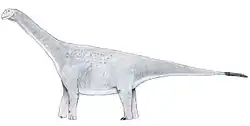| Rhoetosaurus Temporal range: Oxfordian
~ | |
|---|---|
 | |
| Leg bones | |
| Scientific classification | |
| Domain: | Eukaryota |
| Kingdom: | Animalia |
| Phylum: | Chordata |
| Clade: | Dinosauria |
| Clade: | Saurischia |
| Clade: | †Sauropodomorpha |
| Clade: | †Sauropoda |
| Clade: | †Gravisauria |
| Genus: | †Rhoetosaurus Longman, 1926 |
| Type species | |
| †Rhoetosaurus brownei Longman, 1926 | |
Rhoetosaurus (meaning "Rhoetos lizard"), named after Rhoetus, a titan in Greek mythology, is a genus of sauropod dinosaur from the Jurassic (Oxfordian)[1] Walloon Coal Measures of what is now eastern Australia. Rhoetosaurus is estimated to have been about 15 metres (49 ft) long, weighing about 9 tonnes (8.9 long tons; 9.9 short tons).[2] Subsequent authors have sometimes misspelled the name: Rhaetosaurus (de Lapparent & Laverat, 1955); Rheteosaurus (Yadagiri, Prasad & Satsangi, 1979).
Discovery and species

In 1924, Heber Longman, self-trained paleontologist at (and later director of) the Queensland Museum in Brisbane, learned of a large fossil reptile skeleton exposed in the Walloon Coal Measures at Durham Downs near Roma in southern inland Queensland. The station manager, Arthur Browne, forwarded fragments of bone to Longman, and was honoured with the dinosaur's specific name brownei. The initial collection was of 22 tail vertebrae, including a series of 16 consecutive bones, and other fragmentary hindlimb pieces. Soon after Longman announced the new discovery, he visited the station and arranged for more material of the same skeleton to be sent to the Queensland Museum. These included additional vertebrae from the thoracic area, bits of rib, more caudals and more of the femur and pelvis as well as a cervical vertebra. Further material was collected by Mary Wade and Alan Bartholomai in 1975, and still more by Drs. Tom Rich, Anne Warren, Zhao Xijin, and Ralph Molnar. By 2012, prepared material comprised 40 vertebrae, five partial thoracic ribs, part of the sacrum, fragments of the ilia, an ischium, the left and right pubic bones, and much of the right hind limb (femur, tibia, fibula, astragalus, and pes). More bones are yet to be removed from rock.[3]
Rhoetosaurus is among the best-known sauropods thus far discovered in Australia, as well as for the Jurassic of Gondwana.
Relationships
Initially Longman, with advice from leading German paleontologist Friedrich von Huene, noted the primitive nature of Rhoetosaurus, and so for a long time, it was called a cetiosaurid. More recently, others have compared it to Shunosaurus, based on similar general age and several traits of its hind limbs.[3] Given its supposed relationship to Shunosaurus, which had a clubbed tail, Rhoetosaurus has also been hypothesized to possess something similar. The form of the nearly complete hind foot ()at least suggests that lies outside the more derived Neosauropoda, but the material needs further study to determine its precise positioning in sauropod evolution.[3]
References
- ↑ Todd, C.N.; Roberts, E.M.; Knutsen, E.M.; Rozefelds, A.C.; Huang, H.-Q.; Spandler, C. (2019). "Refined age and geological context of two of Australia's mostimportant Jurassic vertebrate taxa (Rhoetosaurus brownei and Siderops kehli), Queensland". Gondwana Research. doi:10.1016/j.gr.2019.05.008.
- ↑ Paul, G.S., 2010, The Princeton Field Guide to Dinosaurs, Princeton University Press p. 173
- 1 2 3 Nair, Jay P.; Salisbury, Steven W. (2012). "New anatomical information on Rhoetosaurus brownei Longman, 1926, a gravisaurian sauropodomorph dinosaur from the Middle Jurassic of Queensland, Australia". Journal of Vertebrate Paleontology. 32 (2): 369–94. doi:10.1080/02724634.2012.622324.
Further reading
- Long JA (1998). Dinosaurs of Australia and New Zealand and other animals of the Mesozoic Era. UNSW Press. ISBN 0-86840-448-9.
- Longman, H.A. (1926). "A giant dinosaur from Durham Downs, Queensland". Memoirs of the Queensland Museum. 8: 183–194.
- Longman, H.A. (1927). "The giant dinosaur Rhoetosaurus brownei". Memoirs of the Queensland Museum. 9: 1–18.










